How Deep Are Septic Tanks Buried? & Location Tips
Author: Omar Alonso | Editor: Omar Alonso
Review & Research: Jen Worst & Chris Miller

Do you have a septic tank on your property? Do you know where it is? Moving into a new home with a septic tank requires an understanding of how septic tanks work. This equipment requires proper use and maintenance to ensure it works correctly. Blockages, overflows, and bad odors are just a few things that can go wrong with it. How deep are septic tanks buried, and how do you locate them in the yard?
Septic tanks usually measure eight by five feet; they're large but buried at depths of four inches to four feet underground. If you have a problem with your plumbing and ablutions, you'll need to know where the tank is, how deep it is, and how deep it's buried.
How Your Septic Tank & System Work
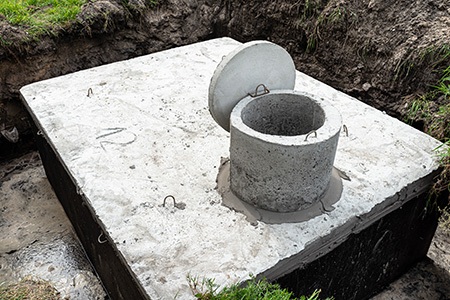
Knowing how the septic tank works gives you better insight into how to maintain and manage it. Properties with septic tanks are usually in rural or semi-rural areas, outside suburbs and cities, and away from traditional sewers and pipelines transporting waste to various government-run facilities.
A septic tank acts as a mini wastewater treatment plant in itself. The plumbing in your home transports "grey" water from the sinks, washing machine, dishwasher, showers, baths, and toilets to the septic tank outside the home.
The septic tank is watertight, preventing the wastewater it collects from leeching into the ground. The internals of the tank separates the liquid waste from the sludge, with the solids sinking to the bottom of the tank and the scum rising to the top of the waterline. The liquid waste sits between these layers.
A T-shaped baffle valve and pipe exit the septic tanks, delivering the wastewater into the drain field outside the tank. The baffle design ensures none of the solids and only the liquids escape through it. The drain field consists of a network of perforated PVC or PEX pipes laid in a trench format underground.
Contractors fill the drain field trenches with gravel or crushed stone during construction, covering the trenches with fabric to prevent dirt from entering the system. The wastewater seeps through the perforations in the pipework, seeping through the gravel into the soil. For this reason, plants and grass thrive around the drain field due to the nitrogen-rich water feeding the area.
The drain field and soil help to remove the harmful bacteria in the wastewater, preventing it from releasing into the groundwater. This is why people are concerned with the question how deep is a septic tank buried. Homeowners require technicians to visit their property every two to three years to pump out the sludge and scum from the septic tank and remove it from the site. This service restores the septic tank to its original state, and the cycle repeats.
How Deep Are Septic Tanks Buried? – Guidelines for Optimal Installations
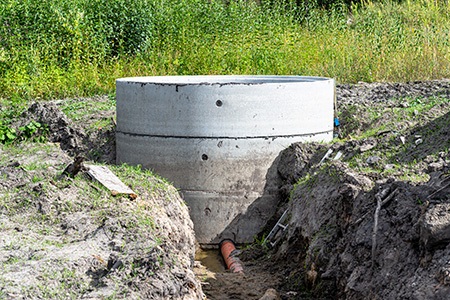
When installing a septic tank, several factors affect its performance and access to it from the surface. Typically, installers bury septic pipes 1.5 feet to 2 feet deep. In warm climates, they'll bury the tank as close to the surface as possible, and in cold temperatures, they bury it deeper, with an additional soil layer on top to prevent the liquids and solids from freezing.
Some installations in cold climates have the tank buried three to four inches under the surface, exposing only the lid. The weight the tank can bear from the soil on top of it also plays a role in determining the depth to which it's buried. Some tanks have specific load-bearing requirements and must feature reinforcement to handle the additional weight on top.
In warm climates, the installation is closer to the surface or slightly above ground due to the septic pipes feeding the drainage field requiring gravity to move out the liquids through the baffle valve.
What Factors Determine Septic Tank Depth?
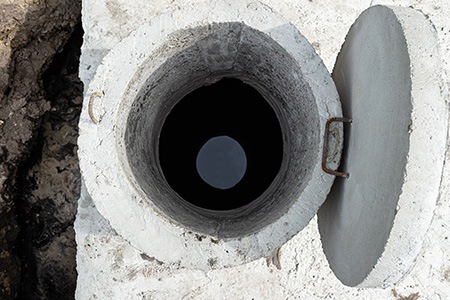
There are several factors that affect not only the optimal location but the septic tank depth. Let’s look at those now.
Type of Septic Tank
Most septic tank system types have similar dimensions and feature design and construction with steel, concrete, plastic, or fiberglass. The concrete and steel models are the most durable but the most expensive.
While manufacturers build standard sizes for septic tanks, usually 4.5 feet wide by 8 feet long and 6 feet tall. However, manufacturers will build custom sizes to suit more demanding requirements for larger properties.
A standard PVC plastic septic tank can usually bear the weight of approximately four to five inches of soil on top of it. Other, more robust models can handle up to five to six feet of earth being laid on top. Burying the septic tank beyond the recommended depth suggested by the manufacturer results in structural damage to the unit and the need for repairs or removal and replacement.
Soil Type & Water Table
When burying the tank in clay-like soils, installation teams must compensate for the compaction of the ground, creating more weight on the top of the tank. As a result, they'll bury it closer to the surface to prevent structural damage.
The installation team examines the soil at the site before burying the tank. In loamy, loose, or sandy soils, there's a lower water table and less saturation of the ground. As a result, the installation team can bury the tank deeper without risking structural damage to the unit.
How to Locate the Septic Tank
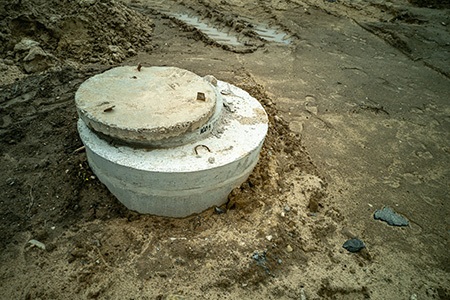
As a homeowner, you need to know where the septic tank is in the yard. If you experience a blockage in the pipes or baffle valve, you'll need to access the tank to resolve the problem. Follow these steps to locate the tank on your property.
Locate the Drainage Pipes
You can follow the pipes to the septic tank if you find the drainage field. Typically, the drainage field and tank are parallel to the sewage line. Look around the basement or crawl space in your home and follow the four-inch sewer pipe.
Probe the ground gently using a 5-foot rod or stick to ensure you're moving in the right direction. Typically, you'll find the septic tank five to 20 feet outside the door. You should eventually run into the lid of the septic tank.
Tips for Planning a Septic Field
The septic tank is only one part of the septic system. The drain field is the septic system component responsible for seeping out the liquid wastewater from the tank. The plant life is a concern for the drain pipes around your septic tank.
You don't want roots from fast-growing shrubs or trees penetrating the tank or the septic pipes leading to the drainage field. If roots break into the tank or lines, the leaks cause contamination of the soil and groundwater. Planting flowers and grass around the tank is fine, but avoid growing anything with woody roots.
Annual species are the best choices for planting around the tank, but you'll have to replace them each year. Be careful of adding soil around the drainage field to prevent blockages, and don't overwater the plants. Choosing low-maintenance species is ideal.
How Deep Does a Septic Tank Need to Be & Other FAQ’s
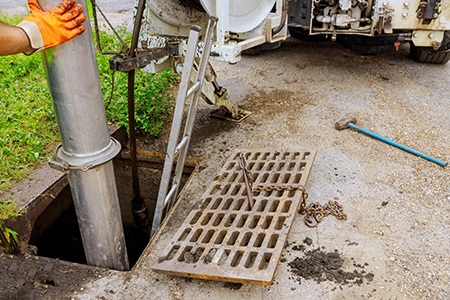
There’s a handful of common questions surrounding this topic of how deep should a septic tank be. Let’s cover those now quickly. There are also some home remedies for backed up septic tanks you can look into if needed.
Can a Septic Tank Be Installed Too Deep?
This is a loaded question. If you're using a standard septic tank, then yes – you can bury the septic tank too deep. Standard septic tanks only have the capacity to be buried up to four feet deep before they lose structural integrity and crack.
However, with the right specs and engineering, a manufacturer can build a custom tank capable of being buried at any depth. Practically, the installer will want to bury the septic tank as close to the surface as possible. The gravity feed to the drainage field is another concern when burying the tank too deeply. This is why the question how deep are septic tanks buried hard to answer.
How Deep Are Septic Tank Trenches?
The septic trench system consists of shallow excavations, typically one to three feet deep and one to five feet deep. The excavation team fills the trench with a minimum 6-inch gravel or crushed stone layer, allowing the wastewater to seep into the soil.
How Do I Use the Slope of the Septic Tank Drain Line to Find the Septic Tank?
The wastewater line coming from the septic tank is usually installed with a 1/8" to 1/4" slope per foot of horizontal run. So, over a distance of one foot, the bottom of the horizontal wastewater pipe should be 1/8 to 1/4" lower than its origin. You'll be looking directly at the septic tank site at this depth and over one foot of horizontal run.
Key Takeaways Surrounding Septic Tank Depth?
- Septic tanks are buried around one to four inches below the surface in warm climates and up to four feet deep in colder climates.
- A septic tank comes in standard dimensions of 4.5 feet wide by 8 feet long and 6 feet tall, featuring construction with concrete, steel, plastic, or fiberglass.
- Burying the tank too deep can result in structural failure and groundwater and soil contamination.
- Burying the tank too deep can also interfere with the gravity feed of the wastewater to the drainage field.
- To find the septic tank on your property, locate the sewer line inside your home and follow it to the septic tank.
- The septic tank is usually five to 20 feet from where the sewer lines exit your home.
How Deep Are Septic Tanks Buried?
How deep does a septic tank need to be? How deep are septic tanks buried? Septic pipes are typically buried 1.5 feet to 2 feet deep. In cold climates the septic tank is buried a bit deeper than in warm climates, though both are very close to the surface of the soil, only a matter of inches. The lid is load bearing to accommodate the weight of the soil, lawn mowers, and people.



